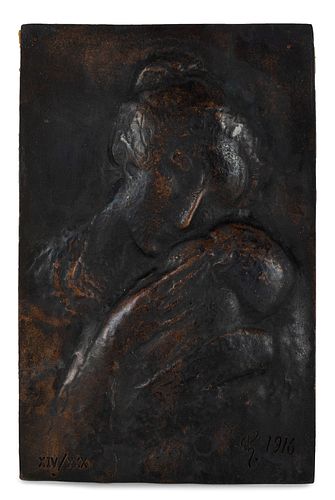PABLO GARGALLO CATALÁN (Maella, Zaragoza, 1881 - Reus, Tarragona, 1934). "Maternity", 1916 Relief in bronze, copy XIV/XXXV.
Lot 39
About Seller
Setdart Auction House
Carrer Aragó 346
Barcelona
Spain
Setdart Subastas was born in 2004 and is currently the first online art auction in Spain with solidity, prestige and reliability guaranteed by our more than 60,000 users. Setdart has a young, dynamic and enterprising team ready to successfully manage the purchase and sale of art works through custom...Read more
Categories
Estimate:
EUR€2,500 - EUR€3,000
$2,688.17 - $3,225.81
Absentee vs Live bid
Two ways to bid:
- Leave a max absentee bid and the platform will bid on your behalf up to your maximum bid during the live auction.
- Bid live during the auction and your bids will be submitted real-time to the auctioneer.
Bid Increments
| Price | Bid Increment |
|---|---|
| EUR€0 | EUR€10 |
| EUR€200 | EUR€25 |
| EUR€500 | EUR€50 |
| EUR€1,000 | EUR€100 |
| EUR€3,000 | EUR€200 |
| EUR€5,000 | EUR€500 |
| EUR€10,000 | EUR€1,000 |
| EUR€20,000 | EUR€2,000 |
| EUR€50,000 | EUR€5,000 |
About Auction
By Setdart Auction House
Oct 27, 2021
Set Reminder
2021-10-27 10:00:00
2021-10-27 10:00:00
America/New_York
Bidsquare
Bidsquare : 19th & 20th Century Paintings & Decorative Arts
https://www.bidsquare.com/auctions/setdart-auction-house/19th-20th-century-paintings-decorative-arts-7767
Setdart Auction House sofia@setdart.com
Setdart Auction House sofia@setdart.com
- Lot Description
PABLO GARGALLO CATALÁN (Maella, Zaragoza, 1881 - Reus, Tarragona, 1934). "Maternity", 1916 Relief in bronze, copy XIV/XXXV. Signed, dated and justified. Work published in "Pablo Gargallo. Catalogoue raisonné, Pierrette Gargallo-Anguera, Ed. Les Editions de l'Amateur, 1998, Paris. Other copies of this same print run have been exhibited in: - "Gargallo", Galerías Laietanas, Barcelona, October 1916, - Gargallo", Wilhelm Lehmbruck Museum, Duisbrug, November-December 1966. - Gargallo", Rodin Museum, Paris, April-June 1970. - Gargallo", Spanish Museum of Contemporary Art, Madrid, October-December 1971. - Gargallo", Palau de la Virreina, Barcelona, December 1971-January 1972. - Centenaire P. Gargallo. 1881-1981", Musée d'Art Moderne de la Ville, Paris, Palau de la Virreina, Barcelona, Fudaçao Calouste Gulbenkian, Lisbonne and Palacio de Cristal, Madrid, 1980-1982. - "Gargallo. Pierres, terres et bronzes. 1900-1394", Galerie Marwan Hoss, Paris, November 1993-January 1994. - Pablo Gargallo", Marlborough Gallery, Madrid, January-February 1994. - Pablo Gargallo", Association Campredon, Art et Culture, L'Isle-sur-la-Sorgue, July-October 1995. Measurements: 13 x 8.5 cm; 34 x 26 cm (frame). Pablo Gargallo was formed in Barcelona, in the School of Fine Arts and as a disciple of Eusebi Arnau, and was related to the artists of "Els Quatre Gats", so his first works will drink of modernism. In 1903 he obtained a scholarship that allowed him to travel to Paris to complete his studies. His stay in the French capital was brief, but from then until 1923, when he settled permanently in Paris, his trips there would be frequent. In this city he found the aesthetic formulations of cubism, assimilated its expressive systems and sought the schematism and essentiality of figures and objects, trying to find the authentic three-dimensional expression of the cubist postulates. During these years he began to use metallic materials such as sheet metal, copper and iron. Around 1911-12 he made his first masks, pieces of great simplification made with cut sheet metal, linked to the cubist aesthetic. Using sheet metal, Gargallo began to suggest volumes and exalt the voids through the penetration of light into the interiors. In 1920 he was appointed professor of sculpture at the Escuela Técnica de Oficios Artísticos de la Mancomunidad de Cataluña, a post from which he was removed in 1923 for political reasons. It was then that Gargallo settled permanently in Paris with his wife and daughter. Gargallo is currently represented in the museum that bears his name in Zaragoza, the MoMA in New York, MACBA in Barcelona, the Museum of Modern Art in Paris and the Reina Sofia in Madrid, among many others.
- Shipping Info
-
In-house shipping available. Please inquire at admin@setdart.com.
-
- Buyer's Premium



 EUR
EUR CAD
CAD AUD
AUD GBP
GBP MXN
MXN HKD
HKD CNY
CNY MYR
MYR SEK
SEK SGD
SGD CHF
CHF THB
THB















